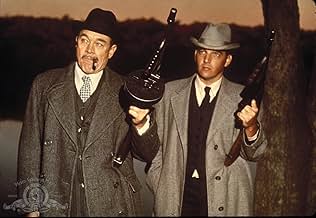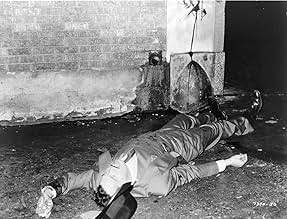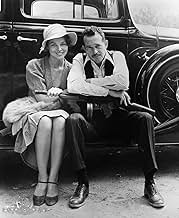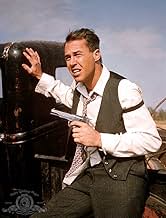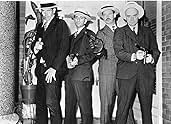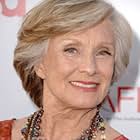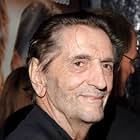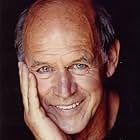John Dillinger and his gang go on a bank robbing spree across the midwest, but one G-Man is determined to bring him down.John Dillinger and his gang go on a bank robbing spree across the midwest, but one G-Man is determined to bring him down.John Dillinger and his gang go on a bank robbing spree across the midwest, but one G-Man is determined to bring him down.
- Awards
- 1 nomination
John P. Ryan
- Charles Mackley
- (as John Ryan)
David Dorr
- Leroy
- (uncredited)
Roland Bob Harris
- Ed Fulton
- (uncredited)
George O. Heath
- John Dillinger, Sr.
- (uncredited)
J. Edgar Hoover
- Self (post-end credits speech)
- (voice)
- (uncredited)
- Director
- Writer
- All cast & crew
- Production, box office & more at IMDbPro
Storyline
Did you know
- TriviaJ. Edgar Hoover protested this film being made and demanded that changes be made to the script to depict the FBI in a better light (see below). Shortly before his death he recorded a disclaimer to the film; it can be heard (spoken by an imitation voice) after the closing credits. The film depicts John Dillinger being shot outside the Biograph after he pulls his gun; in fact, Dillinger never pulled a gun that night. The FBI decided they were going to kill Dillinger rather than attempt to take him alive; they announced their presence, he turned to run, and was shot six times in the back.
- GoofsNotes at the end of the movie claim that Melvin Purvis shot himself with the gun he killed John Dillinger with. In fact, the gun used to self-inflict his fatal wound was given to him by his colleagues at the FBI when he retired in 1935, the year after Dillinger was shot.
- Quotes
[repeated line]
Homer Van Meter: Goddamit! Things ain't workin' out for me today!
- Crazy creditsAfter the closing credits a verbal renouncing of gangster films written by FBI chief J. Edgar Hoover is heard: he was scheduled to read it for the film, but died before it started production. Hoover's text is read at the film's close by voice actor (Paul Frees) decrying the film and calling it a source of corruption for children.
- Alternate versionsTwo different versions with different main title music exist_ The original version features the song "We're in the Money" being played while snap shots of homeless and poor people are shown on the screen. The alternate version has the same visuals but with a simpler instrumental cue (called "Theme from Dillinger" on the soundtrack LP).
- ConnectionsFeatured in Breakaway (1990)
- SoundtracksThe Gold Diggers' Song (We're in the Money)
(uncredited)
Music by Harry Warren
Lyrics by Al Dubin
Sung during the opening credits
Featured review
John Dillinger (Warren Oates) and his gang go on a bank robbing spree across the Midwest, but one G-Man (Ben Johnson) is determined to bring him down.
Following "Bonnie and Clyde" and "The Wild Bunch", American International Pictures wanted their own violent gangster film. Producer Sam Arkoff hired the then-unknown writer John Milius to construct the script. An earlier, very rough version of the script had come in to producer Lawrence Gordon, and Gordon thought Milius – his former assistant -- would be right for the job.
A little research and a solid script would make this an excellent story, but those involved went one step better. Retired FBI Agent Clarence O. Hurt (1897-1975), one of the agents involved in the final shootout with Dillinger, was the film's technical adviser. Hurt had a distinguished career in the gangster era, also being one of the men who brought in Alvin "Creepy" Karpis. Interestingly, Hurt's house was burgled during his funeral – the newspapers liked to say this was the underworld's belated revenge.
In order to save money (Arkoff was always cutting corners), Milius was also offered the director's chair so that AIP would only have to pay one man rather than two. Gordon says this was his idea, but either way the reason was the same. Milius used John Ford as his inspiration, and if you pay close attention you will see homages to Ford's "My Darling Clementine".
The casting of Oates was pure perfection. Although many actors have portrayed John Dillinger before and since, Oates actually resembles the man for the most part. Singer Michelle Phillips as Billie Frechette, Dillinger's girlfriend, came about by an old Hollywood trick: lying. Phillips had told the producers she was half Indian to land her first acting gig.
Arkoff wrote in his autobiography of the ways they saved money on this one; besides the use of Milius, AIP was also selling off the cars after the shoot. So any money they may have spent during filming was in some way regained, even before the first frame hit the movie screens! The script's attention to facts is impressive. Sure, there are some liberties with Melvin Purvis, having him personally strike down more gangsters than he did. And the Little Bohemia Lodge has a few more casualties than it should have, not to mention some guests who weren't really there. By and large, the changes are minor and can easily be dismissed as a way to make the story simpler and more exciting. Having one FBI agent as the hero rather than a dozen is easily to plot out. At least the plot was not a complete fabrication like "Bonnie and Clyde" was; and still, that film is the one that gets more credit.
Upon release, it was inevitable that "Dillinger" would be compared to other gangster films, especially the identically-named "Dillinger" (1945). Dejan Ognjanovic calls Milius' film "the definitive version of the Dillinger story", and he is right. Ognjanovic also rightly notes that Milius paints his characters as mythical beings, larger than life, though the line between good and evil is often blurry. Carlos Clarens wrote that Milius' version "was considerably more romantic" than the 1945 film, despite the "carefully rigged bullet wounds and spurting blood." If nothing else, "Dillinger" deserves some recognition for its role in history: giving John Milius his directorial debut. AIP, especially through Sam Arkoff and Roger Corman, had given rise to numerous filmmakers from Jonathan Demme to Jack Nicholson to James Cameron. Milius may be lesser-known outside of cinephile circles, but his movies are larger than life: "Apocalypse Now", "Red Dawn" and the under-appreciated "Big Wednesday". Lawrence Gordon's career also took off at this point; his cost-cutting measures landed him a gig at 20th Century Fox, where hewent on to specialize in action films such as "Die Hard" and "Predator".
Arrow Video's 2016 blu-ray release gives this film the royal treatment. We have audio commentary by Stephen Prince, the author of "Savage Cinema" and "Screening Violence" (among others), who is an expert on both the violent film genres and gangster history. We also have brand new interviews with producer Lawrence Gordon, director of photography Jules Brenner, and composer Barry De Vorzon. Not enough? There is also a collector s booklet containing new writing by Kim Newman on fictional portrayals of John Dillinger, plus an on-set report containing interviews with writer-director John Milius, illustrated with original production stills.
Following "Bonnie and Clyde" and "The Wild Bunch", American International Pictures wanted their own violent gangster film. Producer Sam Arkoff hired the then-unknown writer John Milius to construct the script. An earlier, very rough version of the script had come in to producer Lawrence Gordon, and Gordon thought Milius – his former assistant -- would be right for the job.
A little research and a solid script would make this an excellent story, but those involved went one step better. Retired FBI Agent Clarence O. Hurt (1897-1975), one of the agents involved in the final shootout with Dillinger, was the film's technical adviser. Hurt had a distinguished career in the gangster era, also being one of the men who brought in Alvin "Creepy" Karpis. Interestingly, Hurt's house was burgled during his funeral – the newspapers liked to say this was the underworld's belated revenge.
In order to save money (Arkoff was always cutting corners), Milius was also offered the director's chair so that AIP would only have to pay one man rather than two. Gordon says this was his idea, but either way the reason was the same. Milius used John Ford as his inspiration, and if you pay close attention you will see homages to Ford's "My Darling Clementine".
The casting of Oates was pure perfection. Although many actors have portrayed John Dillinger before and since, Oates actually resembles the man for the most part. Singer Michelle Phillips as Billie Frechette, Dillinger's girlfriend, came about by an old Hollywood trick: lying. Phillips had told the producers she was half Indian to land her first acting gig.
Arkoff wrote in his autobiography of the ways they saved money on this one; besides the use of Milius, AIP was also selling off the cars after the shoot. So any money they may have spent during filming was in some way regained, even before the first frame hit the movie screens! The script's attention to facts is impressive. Sure, there are some liberties with Melvin Purvis, having him personally strike down more gangsters than he did. And the Little Bohemia Lodge has a few more casualties than it should have, not to mention some guests who weren't really there. By and large, the changes are minor and can easily be dismissed as a way to make the story simpler and more exciting. Having one FBI agent as the hero rather than a dozen is easily to plot out. At least the plot was not a complete fabrication like "Bonnie and Clyde" was; and still, that film is the one that gets more credit.
Upon release, it was inevitable that "Dillinger" would be compared to other gangster films, especially the identically-named "Dillinger" (1945). Dejan Ognjanovic calls Milius' film "the definitive version of the Dillinger story", and he is right. Ognjanovic also rightly notes that Milius paints his characters as mythical beings, larger than life, though the line between good and evil is often blurry. Carlos Clarens wrote that Milius' version "was considerably more romantic" than the 1945 film, despite the "carefully rigged bullet wounds and spurting blood." If nothing else, "Dillinger" deserves some recognition for its role in history: giving John Milius his directorial debut. AIP, especially through Sam Arkoff and Roger Corman, had given rise to numerous filmmakers from Jonathan Demme to Jack Nicholson to James Cameron. Milius may be lesser-known outside of cinephile circles, but his movies are larger than life: "Apocalypse Now", "Red Dawn" and the under-appreciated "Big Wednesday". Lawrence Gordon's career also took off at this point; his cost-cutting measures landed him a gig at 20th Century Fox, where hewent on to specialize in action films such as "Die Hard" and "Predator".
Arrow Video's 2016 blu-ray release gives this film the royal treatment. We have audio commentary by Stephen Prince, the author of "Savage Cinema" and "Screening Violence" (among others), who is an expert on both the violent film genres and gangster history. We also have brand new interviews with producer Lawrence Gordon, director of photography Jules Brenner, and composer Barry De Vorzon. Not enough? There is also a collector s booklet containing new writing by Kim Newman on fictional portrayals of John Dillinger, plus an on-set report containing interviews with writer-director John Milius, illustrated with original production stills.
- How long is Dillinger?Powered by Alexa
Details
- Release date
- Country of origin
- Languages
- Also known as
- Jagd auf Dillinger
- Filming locations
- Oklahoma City, Oklahoma, USA(Nightclub for Purvis engagement party; Purvis meets lady in red; Biograph Theater scene where Dilliger dies)
- Production company
- See more company credits at IMDbPro
Box office
- Budget
- $1,000,000 (estimated)
- Runtime1 hour 47 minutes
- Color
- Aspect ratio
- 1.85 : 1
Contribute to this page
Suggest an edit or add missing content



